|
|
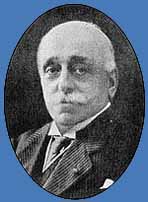 |
|
Boghos
Nubar Pasha |
Boghos Nubar Pasha, in a January
30, 1919 (pg. 6) letter to The Times of London lends evidence on
Armenian military support for the allies during the First World War; Mr.
Nubar's words should make anyone think twice before they conclude the
Armenians were innocent victims.
|
|
|
| Boghos
Nubar's Letter |
The name of Armenia is not on the list of the
nations admitted to the Peace Conference. Our sorrow and our disappointment are deep
beyond expression. Armenians naturally expected their demand for admission to the
Conference to be conceded, after all they had done for the common cause. The unspeakable sufferings and the dreadful
losses that have befallen the Armenians by reason
of their faithfulness to the allies are now fully known.
But I must emphasize the fact, unhappily known to few, that ever since the beginning of the war the Armenians fought by
the side of the Allies on all fronts. Adding our losses in the field to the greater
losses through massacres and deportations, we find that over a million out of a total
Armenian population of four million and a half have lost their lives in and through the
war. Armenia’s tribute to death is thus undoubtedly heavier in proportion than
that of any other belligerent nation. For the Armenians have been belligerents de facto,
since they indignantly refused to side with Turkey. Our volunteers fought in the French
‘Legion Etrangere’ and covered themselves with glory. In the Legion d’Orient they
numbered over 5,000, and made up more than half the French contingent in Syria and
Palestine, which took part in the decisive victory of General Allenby.
In
the Caucasus, without mentioning
the 150,000 Armenians in the Russian armies, about 50,000 Armenian volunteers
under Andranik, Nazarbekoff,
and others not only fought for four years for the cause of the Entente, but after the
breakdown of Russia they were the only forces in the Caucasus to resist the advance of the
Turks, whom they held in check until the armistice was signed
(Boghos Nubar Pasha sent a similar
letter to the French Foreign Minister, Stephen Pichon, below this page.)
Those 50,000 "Armenian
volunteers" were non-Russian (otherwise we would have to assume they would have
joined their army or were drafted into the Russian army), and they had to come from
somewhere. I wonder where?
 |
|
Boghos Nubar
claimed one million survived, along
with the Patriarch and other Armenian sources,
which means 300,000 to not more than 600,000
Armenians died, if you do the math. In his letter, he
falsely claims "over a million" Armenians died, out
of an imagined population of four and a half million.
(Ohhhhh... so three and a half million Ottoman
Armenians survived, despite Boghos' having
claimed elsewhere that only a million survived?
SOME "annihilation," a word many these days
love to use, to sum up the tall genocide tale.) |
Regarding the "four and a half
million" Armenians living presumably in the Ottoman Empire, I guess even Bogus... I
mean, Boghos was not exempt from the apparently genetic characteristic of Armenians to...
ehhhh... "exaggerate." (It would have been in the Armenians' interest to make
the Allies believe there were plenty of Armenians to fill up those Turkish lands... that
they were hoping the Allies would hand over as a "Greater Armenia." See "More
on Boghos Nubar," below.) Throughout this site, I've been
citing three million as the worldwide total of Armenians before World War I (which I
picked up from an Armenian site, and concluded must not have been too off the mark...
although why I would conclude anything from an Armenian site would be true is another
story), and the number of Armenians living within the Ottoman Empire was less than half
that number (1.0 to 1.5 million), according to over half a dozen neutral sources.
DID YOU
KNOW..?
Lloyd George, he of "The Turks are a human cancer" fame, himself described
(in his book) Boghos Nubar's explanations as "fairy
tales"? (George further remarked that Avetis
Aharonian, the other leader of the two Armenian delegations sent to the Peace
Conference, "was as contradictory and confused as Bogos Pasha."; see one
example of his confusion.)
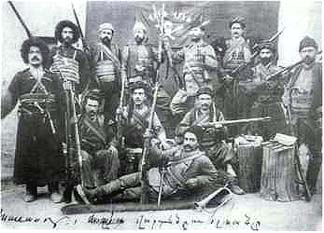
Armenian commander VARTAN (S. Mehrabian)
with a few of his men
|
Who was Boghos Nubar Pasha? Born 1851
in Istanbul (and died 1930 in Paris), he was one of two Armenian delegations sent to
the Paris Peace Conference.
From the web site of the Armenian
Embassy in Canada:
At the start of the twentieth century
the Egyptian Armenians found a new leader, Boghos Nubar, the son of Nubar
Pasha. Boghos had studied agriculture and engineering in Switzerland and France.
Upon his return, he had served as the director of the Egyptian railways and had
supervised the irrigation plan for the Sudan. He had become a banker and corporate
officer in a number of companies and, like his father, was granted the title of
pasha. The massacres of the Armenians in 1895-1896 in Turkey and especially the
Armeno-Azeri clashes in Transcaucasia, beginning in 1905, had a sobering effect on
the Armenian middle class of Egypt. Liberals and disenchanted socialists felt that
there was a need for a world-wide Armenian philanthropic organization. On Easter day (April 15), 1906, ten Armenian professionals met at
Boghos Nubar's mansion in Cairo and drafted the by-laws of the Armenian General
Benevolent Union (AGBU).
Holdwater says:
AGBU's current
budget is twenty seven million dollars. (What they said in April 2003,
anyway.) That's a lot of dough to perpetuate the myth of the "Genocide"...
and it's only one of many well-financed
Armenian organizations.
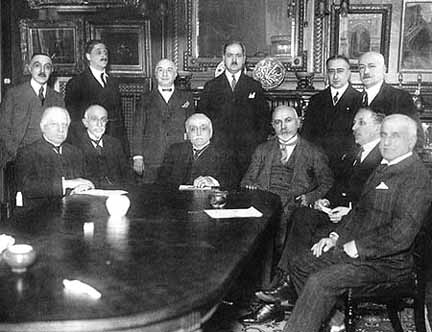 |
|
The
big reunion of AGBU's administrative members, at Boghos Nubar's home in
Paris, 1925. Front row, left to right: unknown, K. Sinabian, B.Nubar, D.
Kélékian,
M. Babadjanian and A. Djévahirdjian. Back row: M. Hékimian, Z. Nubar, S.
Svadjian, L. Gumushgerdan, D. Gamsaragan, L. Pachalian. Holdwater never
realized his lousy high school French would come in handy, in making sense
of all the many Armenian-French web sites. |
From an Egyptian site, extolling the landmarks
of Cairo:
Also not far from the new Victoria
College was another famous landmark, the Ramleh Casino. This fin-de-siecle monument
constructed in 1886-7 was imagined and conceived by Boghos Nubar Pasha, son
of the Armenian statesman-administrator Nubar Nubarian. Having studied at the école
Central in Paris, Boghos was infatuated with the famous casinos and seaside resorts
dotting the Franco-Belgian coast between the fashionable towns of Deauville and
Ostende. The result was Ramleh-Les-Bains's majestic San Stefano Hotel &
Casino.
 |
|
Bugsy
Siegel |
Holdwater says:
Could it be possible the hero of mobster "Bugsy" Siegel was "Boghos"
Nubar? Perhaps opening up a gambling casino in or near a desert was not that novel
an idea....
From the article, "Bulgarian Democracy and the Armenian Connection," in The
Turkish Times:
As the allied armies started landing in
late November 1918, the French army first took the port of Iskenderun and moved to
Cilicia, a region that included the cities of Mersin, Adana, Maras, and Gazi Antep.
The French army, having returned from World War I, was decimated, and a nebulous
adventure in the Middle East was not a national priority in France. For the Cilician
operation a special unit containing mostly Algerians and Armenians was established
in the Island of Cyprus under the command of General Louis Romieu. It was named
"Armenian Legion" similar in the make up of the French Legion d' Orient.
The Cyprus operation originally started
in 1914 by the British to mobilize their colonial armies for the Gallipoli campaign,
but later changed hands in 1916 with the arrival of French forces to establish the
Armenian Legion. For the Cilician operation, most of the recruits came from the
Armenian lobby organized by the son of the former Prime Minister of Egypt, Boghos
Nubar Pasha.
(...)
Financial resources for arms and
operational expenses, including salaries for the Armenian Legion, came largely from
popular subscription campaigns, mounted throughout the war in the United States and
Great Britain, nominally, intended to feed "starving Armenians."
Holdwater: Hmmmm....
it looks like some teary-eyed Americans wishing to feed their suffering Christian brethren might have been bilked.
It appears the above
was based on Prof. Stanford Shaw
sheds light in his "The Armenian Legion and
Its Destruction of the Armenian Community in Cilicia" chapter from the book,
"The Armenians in the Late Ottoman Period." You can read some more here. Prof. Shaw further illuminates:
Cypriot Greeks contributed substantially to the
Legion, providing food, clothing and logistical support for the soldiers while they
were in training. Large numbers of young Armenians came to Cyprus to join the
Legion, mostly as a result of recruitment campaigns organized by the son of the
former Prime Minister of Egypt, Boghos Nubar Pasha, who stirred them with romantic
tales of establishing an Armenian empire stretching from the Black Sea to the
Mediterranean while at the same time, gaining revenge against Turks and other
Muslims. Armenian soldiers who had served in the Ottoman army during the war and
had been captured by the British and imprisoned in concentration camps in Cyprus
also were separated from their Turkish colleagues and enrolled in the Legion. As
time went on, the initial force of Armenian refugees was enlarged by the transfer to
it of Armenian soldiers in the British and French garrisons on the island and in
Egypt as well as Armenians captured by General Edmund Allenby's army that was
advancing from the Sinai Peninsula through Syria during most of 1917... The Armenian
Legion therefore remained on Cyprus until the armistice was signed. In the end it
was brought to Turkey, not by the British, but as part of the French army sent to
occupy Syria and south-eastern Anatolia as a result of the Armistice imposed on the
Ottomans at Mondros in late October 1918.
Holdwater: Little did Boghos Nubar predict that his manipulation
tactics would play a major role in the out-of-control Armenians' making sure to end
the Armenians' presence in the "Cilicia" region.
|
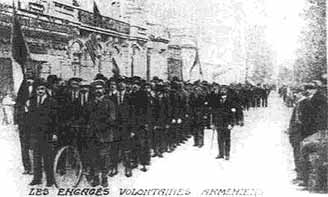
Lining up to join the French
Armenian Legion.
Sacre Bleu! Below, Armenians from that legion.
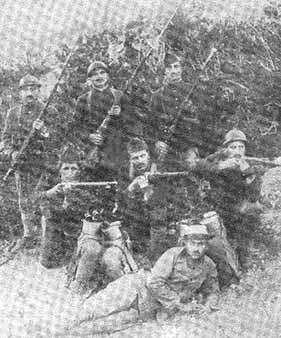
IRONIC BOGHOS BIT
For a fellow who worked so hard against the Turks, it's
interesting the Turks had thought highly enough of Nubar to have offered him a
position in the Ottoman government in 1914. Boghos turned the opportunity
down because he felt his Turkish wasn't up to it. No wonder Nubar did not get
much into the "genocide," in his letter at top... whomever heard of
a government bent on exterminating a people that were actually invited to be
representing that very government?
Source: Taner Akcam, Türk Ulusal Kimligi
ve Ermeni Sorunu ("Turkish National Identity and the Armenian
Question"), Istanbul 1992, p. 151
Interestingly, the above offer came after the official CUP organ, Tasvir i
Evkiar, labeled Nubar as a traitor, since he was urging reform in the
Western capitals. [Near East, V (July 4, 1913), 239.]
|
|
More on Boghos Nubar
Excerpts from the book: A Myth of Terror
An Illustrated Expose by Eric Feigl
Armenian Extremism: Its Causes and Its Historical Context
(From www.ataa.org)
Communist-Bolshevist Russia would long remain an unknown
entity, (No one could have guessed that its politics would differ in absolutely no way
from those of the Czars; the Armenians suspected this least of all!) So after the collapse
of the Czardom, everything that had been promised to the Czars in the Sykes-Picot
Agreement was now promised to the Armenians. It was thus reasonable to expect them to
distinguish themselves a little bit more in the fight against the Ottoman Empire!
Lloyd George, in his well-known flowery style, described Armenia as a land "soaked
with the blood of innocents". Little did he know that he was telling the truth but
that the blood was mostly that of Moslems, who in fact had many more dead to mourn than
the "Christian" Armenians. Lloyd George was just as much a hypocrite as Wilson
and Clemenceau. They had all picked out a "romantic" victim and then dropped her
by the wayside as soon as she ceased to be useful.
When the "peace conference" — which was actually nothing but a
dictate-preparation conference — began meeting in Paris in January of 1919, it appeared
as if the Armenian extremists' hour had arrived. The Armenians sent two delegations to the
"peace conference". One was led by the professional emigrant Boghos Nubar,
who had been working towards the dismemberment of the Ottoman Empire for many years. The
other was from the Republic of Armenia (the existence of which had only been made possible
by the Turks after the Treaty of Baku on May 28, 1918).
The two delegations immediately began "auctioning" — outbidding each other in
demands for territory and underbidding each other in rational arguments. They were
apparently confusing politics with a carpet bazaar, where the important criteria are the
pattern, the number of square meters, and the age of the desired item. Their demands
became so excessive that even such inveterate carpet-lovers as the Allied rulers lost
interest in making a real offer. After all, it did not have to be an Armenian carpet.
Those of the Turks were much older, more valuable, and more reliable.
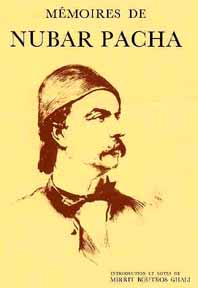 |
|
Memories of Nubar Pasha |
After the Armenian delegation led by Boghos Nubar started
things off by demanding an Armenia in eastern Anatolia, the joint delegation (the group
led by Avetis Aharonian from the Republic of Armenia had in the meantime merged with Nubar)
worked its way up to territorial claims stretching from the Black Sea, with Trabzon as a
harbor, all the way to Cilicia.
The Armenian population of this "Greater Armenia" would not even have accounted
for a fifth of the total population of the region - and that is based on the figures from
1914! Moreover, even if back then in 1914 the entire Armenian population of the world had
gathered in eastern Anatolia, there still would not have been an Armenian majority in the
region.
But so what? In the nineteenth century, the various Armenian churches had wrestled over
who was the "most Armenian." Later, the Dashnaks and Hunchaks both wanted to
carry off the palm in the fight to be the best terrorists. And now, the delegation from
the Republic of Armenia and the one from the Armenian diaspora were outbidding each other
in the same way. As mentioned above, their "common memorandum" claimed not only
the "six vilayets" of Van, Bitlis, Diyarbekir, Karput, Sivas, and Erzurum (in
which the Armenians had never in history had a majority), it also laid claim to Trabzon,
Karabagh (where virtually no Armenians had ever lived), Sansegur, and large parts of
Georgia, as well as Cilicia.
At the same time, the reputation of the Armenians as a nation of peace-loving victims who
had been defenselessly and helplessly murdered (or rather exterminated) by the
bloodthirsty Ottomans was shaken. The reason: The young, autonomous Armenian Republic
could not think of anything better to do than start a whole series of wars of conquest.
The president of the "Armenian National Delegation" sums
up, in a letter (Here it is) to French Foreign Minister Stephen Pichon, why the
Ottomans, who were fighting on five fronts at the same time and were also confronted with
internal Armenian rebellions, had to defend themselves by moving the Armenian population
out of the endangered areas:
Monsieur le Ministre,
I have the honor, in the name of the Armenian National Delegation, of submitting to Your
Excellency the following declaration, at the same time reminding him:
That the Armenians have been, since the beginning of the war, "de facto
belligerents," as you yourself have acknowledged, since they have fought alongside
the Allies on all fronts, enduring heavy sacrifices and great suffering for the sake of
their unshakeable attachment to the cause of the Entente:
In France, through their volunteers, who started joining the Foreign Legion in the first
days and covered themselves with glory under the French flag;
In Palestine and Syria, where the Armenian volunteers, recruited by the National
Delegation at the request of the government of the Republic itself, made up more than half
of the French contingent and played a large role in the victory of General Allenby, as he
himself and his French chiefs have officially declared;
In the Caucasus, where, without mentioning the 150,000 Armenians in the Imperial Russian
Army, more than 40,000 of their volunteers contributed to the liberation of a portion of
the Armenian vilayets, and where, under the command of their leaders, Antranik and
Nazerbekoff, they, alone among the peoples of the Caucasus, offered resistance to the
Turkish armies, from the beginning of the Bolshevist withdrawal right up to the signing of
an armistice."
(The letter bears the date on which it was received in the French Foreign Office -
December 3, 1918). In this manner, Boghos Nubar explained that the Armenians had waged
constant war with the Ottoman Empire from November 1, 1914 right up to the signing of the
Armistice of Mudros on October 30, 1918 and had thus been, in his eyes, "de facto
belligerents."
Holdwater says: In the space of two
months, from the writing of this letter to the writing of The Times of
London letter, the number of those volunteers shot up from 40,000 to 50,000. How
did the Armenians ever attain their favored positions within the Ottoman Empire as
administrators, when they can never get their numbers straight?
|
How Bogus was Boghos?
|
As can been seen, the French did not conceive of establishing an Armenia in Cilicia,
but were planning to border with an Armenia which would be established in the east
(that is in regions which were once relinquished to Russia), and to exert their
influence in that area. In 1920, when the Armenians claimed that they were promised
an Armenia in Cilicia, referring to Bogos Nubar Pasha, the French openly accused
Bogos Nubar of lying. Let us look at the following letter sent by the Ministry
of Foreign Affairs to the President of the Foreign Affairs Commission of the French
Senate on 28 December 1920:
. . . You have asked me whether in 1916, or since that date, the French Government
had engaged itself in regard to Armenia, to constitute an autonomous Cilicia.
. . . I have the honour of informing you that no engagement of this nature ever took
place.
. . . Bogos Pasha claims that M. Geroges Picot assured him in London that France had
engaged herself to give, after the victory of the Allies, autonomy to Cilicia under
her protection.
This so called engagement was apparently the counterpart of the recruiting of the
Armenian legion, which had been formed at the suggestion of M. Georges Picot, to
help to drive the Turks from Cilicia.
To strengthen his claim, Bogos Pasha cites a telegram he sent to his son in Cairo,
through the mediation of the Ministry of Foreign Affairs, in order to take the
necessary measure for the establishment of the Armenian legion. He adds that,
Commander Romieu, charged with this formation, confirmed to the Armenian notables
the agreement reached in London, and read them a letter written by M. Briand, who
was then the President of the Council, in which he declared that he was in agreement
with the national Armenian delegation.
M. Georges Picot has never informed the Ministry of the discussion he had with Bogos
Pasha in London:' As a matter of fact, he had no authority which would permit him to
engage the French Government.
The telegram sent by Bogos Pasha to his son only states `the official assurance that
the national aspirations of the Armenians be satisfied when the Allies are
victorious'. The department would not have sent this telegram if it had concerned
Cilicia. Cilicia was not mentioned in this telegram. The sentence which is quoted
could only refer to the establishment of an Armenian state within the limits
determined by the Powers. This is exactly what was done by the Treaty of Sèvres.
There is no evidence in the Archives of the Foreign Affairs indicating that M.
Briand wrote a letter to Commander Romieu.
There is no document of any kind which confirms the claim made by Bogos Nubar Pasha
that M. Georges Picot assured him that `France would create an autonomous Armenia,
after she conquers Cilicia, within the limits of the 1916 agreement'. . . .
This letter continues by proving that Bogos Nubar Pasha made unfounded claims. We
have included this letter here, in order to indicate to what extent Bogos Nubar
Pasha, who took upon himself the right to speak on behalf of Armenia, can be
trusted.
From Kamuran Gürün's "The Armenian
File"; extra insight into this period regarding French and Armenian actions
in Cilicia may be found here.
Other authors have reached different conclusions on the matter:
"In the course of
Franco-British negotiations for amendments to the Sykes-Picot Agreement at the
French embassy in London during October 1916, Nubar proposed to recruit Armenians on
a worldwide scale to fight the Turks under French officers, provided that these
troops should become the nucleus of defense for an autonomous Cilicia under French
protection after the war. Georges-Picot agreed, if only verbally, and thus incurred
for France a political obligation beyond the Sykes-Picot Agreement to establish
herself in Cilicia. Paris sealed the pact on 28 January with the creation of the
Détachement francais de Palestine-Syrie. This unit was a brigade, formed under the
command of Lieutenant Colonel Philipin de Piépape..."
From "The Tricolor Over the Taurus," p. 15.
The fact that Georges-Picot agreed
"verbally" would be a difficult matter to prove, wouldn't it? No source is
offered in the footnotes. Probably the "word" of Boghos Nubar was good
enough for the book's author.
|
| More on Bogus Boghos |
"...The Armenian delegation demanded independence for Cilicia. To
this, the French delegate replied, in the name of France, that since a special form of
administration had not been stipulated for Cilicia by the Treaty of Sèvres, it would be
difficult to bestow sovereignty on this country. Nevertheless, the French government would
do its best to protect the Armenian minority. Upon this, Bogos Nubar indicated that the
Armenians in Cilicia were not a minority but a majority."
"The Armenians in History and the Armenian Question," Esat Uras, 1988, p. 965
|
|